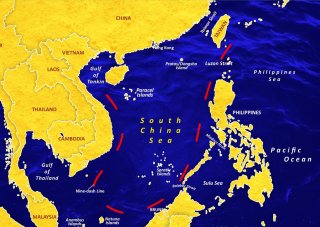America Cannot Dismiss China’s 10-Dash Map
The United States must not stand idly by as China tries to redraw the world map.
Last week, China released a new map called the 10-Dash map as a successor to Dash-9. This map represents an escalation by Beijing to further extend its unilateral redrawing of international boundaries. It is an extraordinarily provocative move. It also violates the International Law of the Sea.
With the 9-dash line, China brazenly claims waters which are thousands of miles away from its territory, but along the coast of smaller nations. The latest map further solidifies those claims and expands upon them with the addition of one more “dash” around Taiwan. The United States must not stand idly by as China tries to redraw the world map.
Beijing's intent is to, first, acquire more territory and resources as some of these areas are rich in hydrocarbons; second, increase pressure on Taiwan by edging closer to its boundaries; and third, flex its muscles with its neighbors while testing U.S. reaction and resolve.
The publication of the 10-Dash map indicates that China is getting bolder in pursuing its strategic objective to change the regional balance of power and pursue regional hegemony.
The countries of Southeast Asia, who are directly threatened by this Chinese action, are furious and have responded strongly, with some stating that they will take measures necessary to defend their territory. But it is not clear what those measures will be, and their collective failure to respond effectively to 9-Dash has clearly emboldened China to push ahead.
The latest Chinese action has serious implications for the United States, and it would be a mistake to just dismiss this as bluster. We have treaty commitments to some of the countries threatened, including the Philippines. Our supply chain for several strategic items depends on unfettered access to the region. We simply cannot allow the arbitrary expansion of Chinese power to stand.
Countries in the region are watching for a U.S. response and are more open than previously to the prospect of greater security and military cooperation with the United States. Chinese hegemony in the region will change the global balance of power and directly threaten our vital national interests.
What should we do? Having just returned from a trip to Southeast Asia, I recommend the following measures be taken:
1. Deter Chinese escalation and aggression. For this, we will need to address gaps in our capabilities and those of our allies. Burden-sharing must become a hallmark of our rebalancing of power in the region. We must learn from our mistakes in Europe during the containment of the former Soviet Union. We should not and need not carry a disproportionately heavy amount of that burden.
2. Addressing the chasm in shipbuilding should be a priority. China’s shipyards have a capacity that far exceeds U.S. shipyards, by orders of magnitude—some estimate the gap is 25 million gross tons per year in China vs. 100,000 gross tons per year in the United States. Furthermore, China builds ships for a much lower cost. We must expand our industrial base for manufacturing ships. We should also take advantage of allied capabilities. For example, South Korea has the capacity to produce ship hulls. Some of our laws and policies stand in the way of cooperative production, but there are shelf-ready solutions. The rules should be changed to allow neutral components to be manufactured elsewhere, with the more sensitive capabilities subsequently installed in either the United States or another allied country.
3. Burden sharing and pooling resources should extend to maintenance and repair work on our and allied ships to get them back into commission more quickly. For example, we are in an advantageous position with our nuclear submarines, but many are in maintenance for extensive periods largely because of the legal requirement for only American entities to do the work. This requirement should be appropriately reviewed and adjusted.
4. Our aircraft and those of our allies are vulnerable to Chinese missiles on airfields without hardened shelters. Our allies should assume a greater portion of this burden by assuming broader responsibility for hardening these facilities across the region.
5. The United States must assume the role of dispute mediator among the bickering nations affected by China’s Dash-10 provocation. Each nation is clear that the move is a violation of their borders, their sovereignty, and their security. They all have a strong shared interest in meeting this threat. But bilateral disputes among them are impeding their ability to act. This is an important opportunity for the United States to quietly step in as a mediator and work behind the scenes to help resolve these disputes. Such a strategic move would enable the affected countries to pursue joint cooperative policies against Chinese provocations.
These steps are necessary if we are to avoid further aggressive moves by China. The geopolitical risk is outsized. Without taking such bold measures, China may well miscalculate its capacity to continue this encroachment and overreach. There is a distinct potential for this strategic trend to lead them into a major regional conflict. We must take concrete steps like these now in order to preclude such a development.
Zalmay Khalilzad is a former U.S. Ambassador to the United Nations.
Image: Shutterstock.

